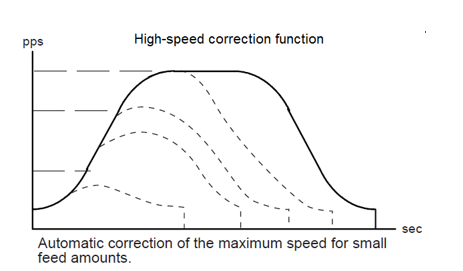HSPD – High Speed Set Point
Sets the high moving speed at the time of starting axis motion, or reads the current set value. The moving start speed can be set as a global value, or set for each axis.
Applies to: CMD-4CR, CMD-4EX-SA, PMX-2ED-SA, PMX-2EX
ASCII/Standalone HSPD global high speed setting
HSPD[axis] individual axis high speed setting
Applies to: PMX-4EX-SA, PMX-4ET-SA
ASCII HS global high speed setting
HS[axis] individual axis high speed setting
Standalone HSPD global high speed setting
HSPD[axis] individual axis high speed setting
For all examples below, replace HSPD with HS for ASCII mode when working with a PMX-4EX-SA and PMX-4ET-SA.
Syntax:
Read:
HSPD[axis]
HS[axis] * For PMX-4EX and PMX-4ET ASCII mode only
|
Where: [axis] is set to X, Y, Z, U, or not specified to read global value |
Write:
HSPD[axis]=[hspd]
HS[axis]=[hspd] * For PMX-4EX and PMX-4ET ASCII mode only
|
Where: [axis] is set to X, Y, Z, U, or not specified to write global value [hspd] is motion high speed (pps) with range of 1 – 6,553,500, * [hspd] must be set higher than the LSPD value. |
Reply
Command is accepted and executed
Read:
Value of HSPD, range of 1 – 6,553,500
Write:
OK
Command cannot be processed
An error message is returned. See Error Codes
Example:
Read: HSPDX * returns the value set for HSPD for the X axis
Write: HSPDZ=50000 * sets motion high speed for Z axis to 50,000 pps
Notes:
- HSPD must be larger then 0.
- HSPD and HSPD[axis] must be a positive value. If a negative value is entered, the absolute value is used. Example entering HSPD=-1000 will set HSPD to 1000.
- HSPD and HSPD[axis] must be greater then or equal to LSPD and LSPD[axis].
- Individual high-speed settings will take priority over the global high-speed settings. A global high-speed setting will only be used when either of the following conditions is true:
- The corresponding individual high-speed setting is defined as zero.
- An interpolated motion is being performed.
In the example below, the settings will set both the global speed settings as well as the individual speed setting for the X axis.
HSPD=10000
HSPDX=2000
LSPD=300
ACCX=500
ACC=300
DEC=300
In this example, once a move command is issued, the global speed settings for the low speed and deceleration, as well as the individual X-axis speed settings for the high speed and acceleration, will be used for motion.
- StepNLoop
- When StepNLoop is enabled and not making an interpolated move, high speed units are encoder counts per second.
- When StepNLoop is disabled or interpolated moves are commanded, the high speed units are pulse per second.
- The minimum and maximum acceleration/deceleration values depend on the high-speed and low-speed settings. Refer to Speed Settings for details.
- Only in V127 firmware for CMD-4CR and CMD-4EX, the SSPDM[axis] Speed Range setting must be set to accommodate the desired speed value, or set to 0 for automatic setting. See SSPDM – Speed Range for more information.
- Based on speed magnification resolution, actual speed can very from commanded speed by up to 0.1%.
- Sometimes it is not possible to reach the high speed requested by the high speed command based on the acceleration, deceleration times and distance commanded. In the S-curve mode, the CMD-4CR and CMD-4EX will automatically calculate a new HSPD, which is only used for that move and allows for the quickest and smoothest possible move for the requested acceleration, deceleration times and distance commanded.

See also:
ACC, DEC, JKA, JKD, LSPD, PS, SCV, SSPDM
